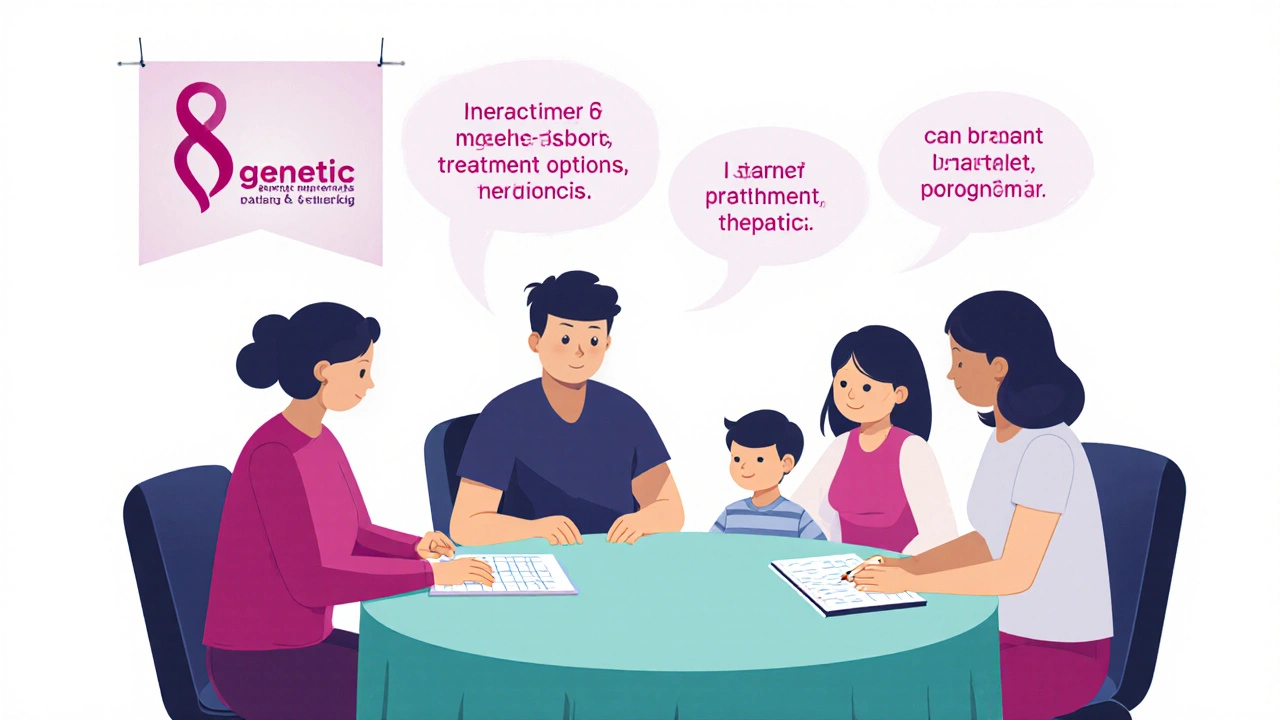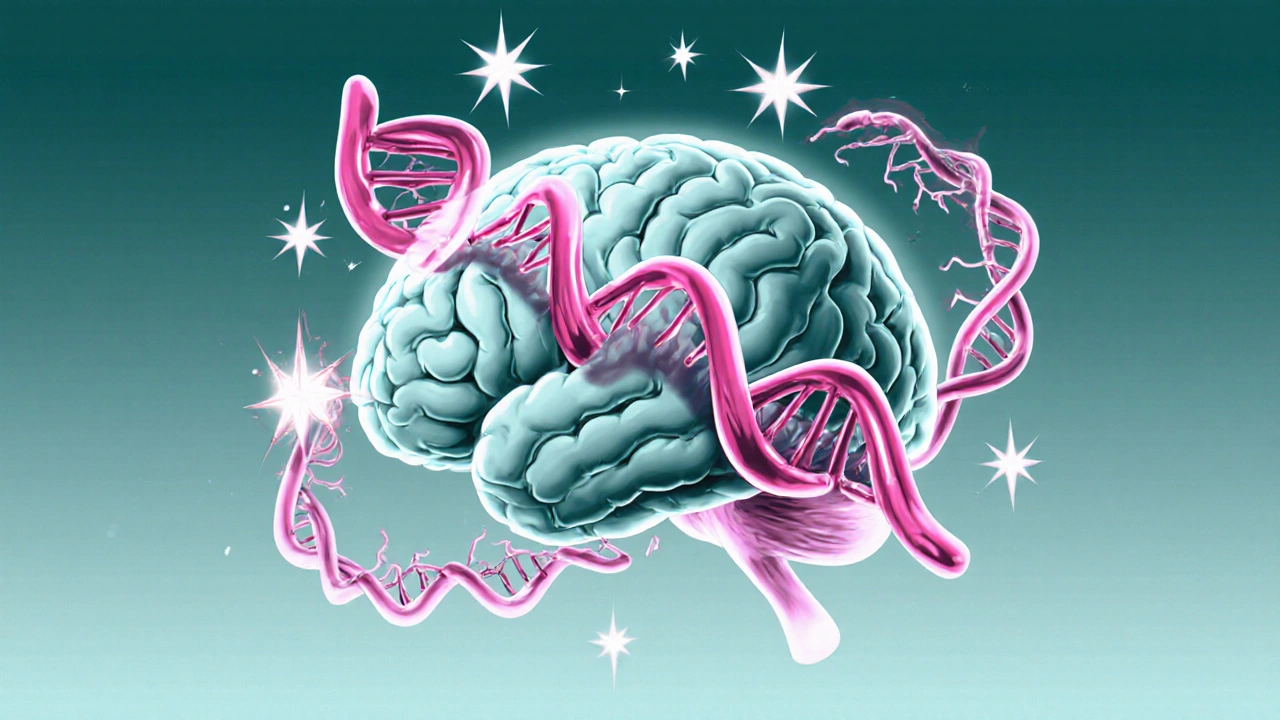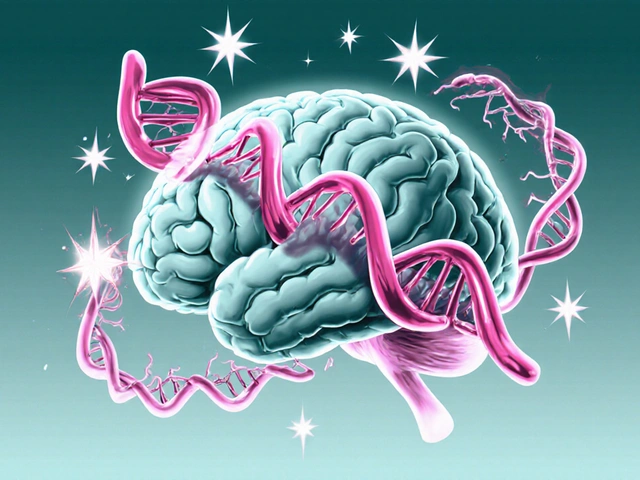Genetic Treatment Compatibility Checker
Select Genetic Factor or Seizure Type
When you hear the word Genetic factors in seizure disorders refer to the inherited or de novo DNA changes that increase the risk of experiencing seizures, it can feel both hopeful and overwhelming. Over the past two decades, researchers have pinpointed dozens of genes that can tip the brain’s electrical balance, and clinicians now have tools to test for many of them. This article walks you through what we know about the genetics of seizures, which genes matter most, how testing works, and what a genetic diagnosis means for treatment and daily life.
Why genetics matters for seizures
Seizures happen when neurons fire abnormally. While some triggers are obvious-like fever, head injury, or electrolyte imbalance-many people discover that their seizures run in families or start in childhood without an obvious cause. In those cases, Epilepsy is a broad term for recurrent, unprovoked seizures that can have genetic underpinnings. Understanding the genetic component helps doctors predict the seizure type, choose the most effective medication, and offer families a clearer picture of recurrence risk.
Key genes and the seizures they drive
Not all genes are created equal. Some cause rare, severe syndromes; others contribute modestly to common epilepsy forms. Below is a snapshot of the most frequently studied genes and the seizure phenotypes they produce.
| Gene | Associated Syndrome / Seizure Type | Typical Onset Age | Treatment Highlights |
|---|---|---|---|
| SCN1A encodes the Nav1.1 sodium channel | Dravet syndrome, generalized epilepsy with febrile seizures plus (GEFS+) | First year of life | Avoid sodium‑channel blockers; consider stiripentol, fenfluramine, or cannabidiol |
| KCNQ2 codes a potassium channel subunit | Neonatal epileptic encephalopathy | Neonatal period | Ezogabine (retigabine) or carbamazepine can be effective |
| CHRNA4 subunit of the nicotinic acetylcholine receptor | Autosomally dominant nocturnal frontal lobe epilepsy (ADNFLE) | Childhood to early adulthood | Carbamazepine or oxcarbazepine are first‑line |
| PCDH19 | Epilepsy of infancy with migrating focal seizures | Infancy (6‑12 months) | Clobazam, stiripentol, or benzodiazepines |
| GRIN2A | Landau‑Kleffner syndrome, focal epilepsy | Early childhood | Phenobarbital or valproate; experimental NMDA‑modulators |
How genetic testing works
If a clinician suspects a genetic cause, they will usually start with a genetic test that examines DNA for known pathogenic variants. There are three common approaches:
- Targeted gene panels: Look at 20‑100 epilepsy‑related genes. Fast and cost‑effective, ideal when a specific syndrome is suspected.
- Whole‑exome sequencing (WES): Sequences all protein‑coding regions (≈20,000 genes). Whole‑exome sequencing captures rare or novel variants that panels might miss.
- Whole‑genome sequencing (WGS): Reads the entire DNA molecule, including non‑coding regions. Used when WES is inconclusive and a hereditary pattern is still likely.
Blood is the most common sample, but saliva kits are increasingly accepted for children who find venipuncture stressful.
When to consider testing
Genetic testing isn’t needed for every seizure patient, but certain red flags raise the odds of a DNA cause:
- Seizure onset before age two, especially with developmental delay.
- Family history of epilepsy, febrile seizures, or unexplained sudden death.
- Resistance to at least two appropriately chosen antiepileptic drugs (AEDs).
- Accompanying neurological features-speech regression, movement disorders, or visual impairment.
- Specific seizure patterns, such as nocturnal frontal lobe bursts or prolonged status epilepticus.
When any of these appear, a referral to a neurologist or clinical geneticist is warranted.
Impact of a genetic diagnosis
Getting a clear genetic answer can change the course of care in three ways:
- Therapeutic selection: Some genes predict drug response. For example, SCN1A mutations typically worsen with sodium‑channel blockers, so clinicians avoid them.
- Prognosis & counseling: Knowing the exact syndrome helps families anticipate developmental milestones, seizure frequency, and risk of comorbidities.
- Precision medicine trials: Several gene‑specific therapies are in late‑stage trials (e.g., antisense oligonucleotides for SCN2A). A diagnosis can make a patient eligible for experimental treatments.
Common pitfalls and how to avoid them
Even with advanced testing, misinterpretation can happen. Here are frequent mistakes and tips to sidestep them:
- Assuming a variant is pathogenic: Not all DNA changes cause disease. Look for “clinically significant” or “pathogenic” labels in the report, and ask your doctor about the evidence level.
- Over‑relying on a negative result: A normal panel doesn’t rule out a genetic cause; the gene might not be on the list or the mutation could be in a non‑coding region.
- Ignoring family testing: If a variant is found, testing close relatives can clarify inheritance patterns and guide future family planning.
Resources and next steps for patients and families
If you’re navigating a new diagnosis, these practical steps can help:
- Schedule a follow‑up with a neurogenetics specialist to discuss the report in plain language.
- Ask for a written summary that lists the gene, mutation type, and recommended medication adjustments.
- Connect with patient advocacy groups such as Epilepsy Foundation or disease‑specific communities (e.g., Dravet Syndrome Foundation).
- Consider a comprehensive care plan that includes a neurologist, genetic counselor, psychologist, and educational therapist.
- Stay informed about clinical trials. Websites like ClinicalTrials.gov let you filter by gene and condition.
Remember, genetics is just one piece of the puzzle. Lifestyle factors, medication adherence, and supportive environments remain crucial for seizure control.
Key takeaways
- Genetic factors drive up to 30% of epilepsy cases, especially those with early onset.
- Genes such as SCN1A, KCNQ2, and CHRNA4 have well‑characterized seizure phenotypes.
- Targeted panels, WES, and WGS are the main testing options; choose based on clinical clues.
- A confirmed genetic diagnosis guides medication choice, informs prognosis, and may unlock precision‑medicine trials.
- Work with a multidisciplinary team and use reputable patient‑support networks to stay empowered.
Can lifestyle changes reduce seizure frequency in genetically driven epilepsy?
Yes. Even when a gene mutation is the primary trigger, factors like sleep hygiene, stress management, and avoiding known seizure provokers (e.g., flashing lights) can lower attack rates. Consistent medication adherence remains the cornerstone.

Is genetic testing covered by insurance in Australia?
Many private insurers and Medicare now fund targeted epilepsy panels when a neurologist deems them medically necessary. Whole‑exome or whole‑genome sequencing often requires additional justification or a referral to a genetics clinic.
What does a "variant of uncertain significance" (VUS) mean?
A VUS indicates that a DNA change has been found, but current scientific evidence isn’t enough to label it harmful or harmless. Over time, research may reclassify it. Genetic counseling can help interpret its relevance for your family.
Are there any FDA‑approved drugs that target specific epilepsy genes?
While no drugs are officially gene‑specific yet, some medications have shown efficacy in certain genetic subtypes. For instance, fenfluramine and cannabidiol are approved for Dravet syndrome (SCN1A), and ezogabine works well for KCNQ2‑related neonatal seizures.
How reliable are direct‑to‑consumer (DTC) genetic tests for seizure risk?
DTC kits usually examine only a handful of common variants and lack clinical validation. They might miss rare, high‑impact mutations, so a negative DTC result should not replace a professional genetic evaluation if you have clinical concerns.



Michaela Dixon
October 24, 2025 at 12:00The tapestry of seizure genetics unfurls like an ever‑expanding map, each locus a landmark that guides clinicians through the fog of unknown etiology. From the early discoveries of SCN1A mutations turning neonates into fragile storm‑chasers, to the recent whispers of non‑coding variants lurking in the shadows of whole‑genome data, the field has leapt forward in a cascade of breakthroughs. Researchers have catalogued dozens of ion‑channel genes that tip the delicate balance of neuronal excitability, and each addition amplifies our capacity to match a child’s seizures to a precise molecular culprit. The practical upshot is that a genetic diagnosis no longer sits on a dusty shelf; it actively reshapes therapeutic choices, steering doctors away from sodium‑channel blockers when SCN1A is at fault and toward newer agents like fenfluramine or cannabidiol. Moreover, families gain a crystal ball of sorts, peering into recurrence risks and developmental trajectories that were previously shrouded in uncertainty.
Beyond the headline genes, a host of modifiers-common variants that whisper rather than shout-simmer beneath the surface, influencing seizure frequency and drug response in subtle ways. The advent of targeted panels, whole‑exome sequencing, and now whole‑genome sequencing provides a tiered toolbox, each layer offering deeper resolution at increasing cost and complexity. While a panel can swiftly capture the usual suspects, exome and genome approaches rescue patients whose phenotypes defy classic patterns, uncovering rare de novo events that would otherwise remain hidden.
Clinical practice has begun to incorporate these tools as part of a broader diagnostic algorithm: red‑flag cues such as onset before two years of age, developmental delay, or refractory status prompt referral to a neurogenetics specialist. Once a pathogenic variant is confirmed, the care team can convene-neurologist, genetic counselor, psychologist, and therapist-to craft a personalized roadmap that blends medication optimization with psychosocial support.
Importantly, the narrative does not end at diagnosis. Precision‑medicine trials are blossoming, with antisense oligonucleotides aiming to silence mutant transcripts for SCN2A and related genes, while gene‑replacement strategies inch toward clinical reality. For families, staying attuned to trial registries can be the difference between merely managing seizures and potentially altering the disease course.
Finally, the community dimension cannot be overstated. Patient advocacy groups, online forums, and disease‑specific foundations act as lifelines, offering everything from educational webinars to grant assistance for testing. In sum, the convergence of genomic insight, therapeutic nuance, and community empowerment is turning what once seemed an immutable destiny into a landscape of hope and actionable choice.
Dan Danuts
October 24, 2025 at 13:23What a fantastic walk‑through! It’s amazing how each piece of genetic info can light the way to a better treatment plan, and you’ve laid it out so clearly that even newcomers can grasp the big picture.
Dante Russello
October 24, 2025 at 14:46Indeed, the step‑by‑step approach you described mirrors what we see in multidisciplinary clinics. When patients bring a clear red‑flag-early onset, developmental concerns, or drug resistance-the genetics team can prioritize a targeted panel, which often yields results within weeks, saving precious time for families.
James Gray
October 25, 2025 at 15:46Yo, I totally agree that getting a gene test early can change the whole game for kids. Plus, the newer meds like fenfluramine are actually making a difference for those with SCN1A mutations.
Scott Ring
October 25, 2025 at 17:10That’s a solid point-knowing the exact mutation helps us avoid harmful drugs and pick the ones that truly help. It also eases the family’s worries when they have a clear roadmap.
Shubhi Sahni
October 26, 2025 at 18:33Genetic testing can be pricey, but many insurers cover panels.
sara fanisha
October 26, 2025 at 19:23True, and don’t forget that some labs also offer financial assistance programs if the insurance denial becomes a hurdle.
Tristram Torres
October 27, 2025 at 22:20Honestly, all this hype about genetics feels like a marketing ploy; most patients will never benefit from these expensive tests.
Zachary Blackwell
October 27, 2025 at 23:43Well, the "marketing ploy" theory ignores the fact that big pharma and tech giants are quietly pushing hidden agendas, funneling data into ecosystems that track every seizure episode and sell it back to insurers.